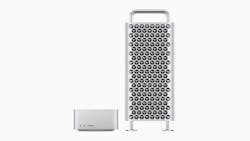Apple Completes Shift to In-House Silicon with New SoC for Mac Pro
Over the last decade, Apple transformed into one of the most formidable players in the semiconductor market with its in-house A-series systems-on-chips (SoCs) for the iPhone. But the consumer electronics giant has been upping its game in recent years with the M-series chips, which sit at the heart of its Mac lineup of laptop and desktop PCs.
At its recent Worldwide Developer Conference, Apple said the upcoming Mac Pro will be the last model in the Mac lineup to be equipped with Apple silicon. It completes the company’s transition from Intel chips to homegrown processors.
Apple said the latest iteration of its Mac Pro, which comes in a tower-shaped or rack-mounted enclosure, will be powered by the new M2 Ultra. The Arm-compatible SoC consists of a pair of its previous M2 Max chips bonded together using a proprietary interconnect, bringing a major boost in performance for video editors, software designers, and other “pro” users that need the most computing power and connectivity.
The M2 Ultra is claimed to be up to 3X faster than the Intel Xeon-class CPU at the heart of Apple’s existing Mac Pro. That enables it to handle computationally heavy workloads such as video transcoding and modeling 3D objects.
The move marks the start of a new era for Apple, which launched its first custom-made Arm-based PC chip, the M1, in 2020. Since then, the company has been building out the M-series to the point where it now includes an entire family of high-performance SoCs, including the M1 Pro, M1 Max, and M1 Ultra—the largest and most advanced of the offerings—and a second generation starting with the base M2 launched in 2021. The M2 Ultra co-packages a pair of M2 Max chips, a more advanced variant of the M2.
Unveiled in January, the M2 Max pushed the limits of silicon engineering with 67 billion transistors in a form factor small enough for a PC. But Apple is taking things a step further with the M2 Ultra. The SoC uses the company’s proprietary interconnect called UltraFusion to bind together two M2 Max chips in a package that can challenge data-center chips in terms of transistor density. UltraFusion technology allows the die to connect over 10,000 signals and support 2.5 Tb/s of low-latency chip-to-chip bandwidth.
“This completes the transition to Apple silicon, which has completely transformed the desktop and laptop experience,” said John Ternus, senior VP of hardware engineering at Apple, in a statement.
The Hardware Under the Hood
Based on a second-generation 5-nm process node from TSMC, the new chip crams 134 billion transistors on a silicon interposer, said Jennifer Munn, director of engineering program management at Apple. That’s 20 billion more transistors than the M1 Ultra, which uses the same underlying architecture. And it beats out the approximately 80 billion transistors in NVIDIA’s latest AI-focused H100 GPU targeted at data centers.
Using the UltraFusion technology gives the M2 Ultra a 24-core CPU consisting of 16 high-performance cores and eight efficiency cores. The result, per Apple, is 20% faster performance in the CPU than the M1 Ultra.
Apple said UltraFusion—which it introduced last year in the M1 Ultra—binds everything together in such a way that the software interprets the package as a single chip. As a result, code can be ported from the single-chip offerings in Apple’s Mac lineup to the new M2 Ultra without difficulties.
Internally designed by Apple, the GPU can be equipped with 60 or 76 cores, giving it up to 30% more performance than the GPU in the M1 Ultra at the heart of the company’s Mac Studio, which has a maximum of only 60 cores.
Another upgrade is the unified memory that sits inside the M2 Ultra. The SoC can be configured with up to 192 GB of memory capacity—50% more than the M1 Ultra at the heart of the previous Mac Pro—while it features 800 Gb/s of memory bandwidth, which is more than double what’s possible with the M2 Max.
Apple said the increased memory means that it can take on workloads “other systems can’t even process.” That even includes training machine-learning (ML) workloads, such as large transformer models at the heart of ChatGPT and other types of “generative” AI, without offloading to the cloud.
According to Apple, even NVIDIA’s most advanced discrete GPU for the PC market is unable to process these types of ML models because it lacks enough GDDR6 memory to do the job—sans cloud.
The M2 Ultra is also equipped with a 32-core neural processing unit to handle on-device machine learning. At up to 31.6 trillion operations per second (TOPS), the AI engine offers 40% faster performance than M1 Ultra.
What Else is Inside?
The Apple-designed media engine in the Ultra SoC can handle hardware acceleration of the company’s ProRes codec used in video compression, enabling the efficient playback of up to 28 streams of ultra-high-resolution 8K video.
Apple said the Mac Pro taps the media engine in the M2 Ultra to perform the work of seven Apple expansion cards that could be attached to the company’s Intel-based Mac Pros for video processing. On top of that, when the Mac Pro is equipped with six video I/O cards, it can ingest 24 4K camera feeds and encode them to ProRes in real-time.
The seven expansion slots in the tower-shaped workstation can support PCIe Gen 4, which the Apple said is double the data rate of the previous Intel-based Mac Pro that only supported up to PCIe Gen 3.
Like its predecessors, the M2 Ultra also integrates Apple’s in-house "secure enclave" that bakes in hardware-verified secure boot and other hardware protections to try to keep the system and data stored there safe from attackers.
The display engine inside can support up to six Apple Pro XDR displays, totaling more than 100 million pixels. The Mac Pro comes with dual high-bandwidth HDMI ports that support up to 8K resolution and 240-Hz frame rates, too.
The M2 Ultra-powered Mac Pro features eight Thunderbolt 4 ports, three USB-A ports, and dual Ethernet ports for wired connectivity. Wireless connectivity is supported by Wi-Fi 6E and Bluetooth 5.3.
But the capabilities of the M2 Ultra cost a premium. The Mac Pro starts at $6,999 for the tower-shaped enclosure and $7,499 for the rack-mounted model.
About the Author
James Morra
Senior Editor
James Morra is the senior editor for Electronic Design, covering the semiconductor industry and new technology trends, with a focus on power electronics and power management. He also reports on the business behind electrical engineering, including the electronics supply chain. He joined Electronic Design in 2015 and is based in Chicago, Illinois.


